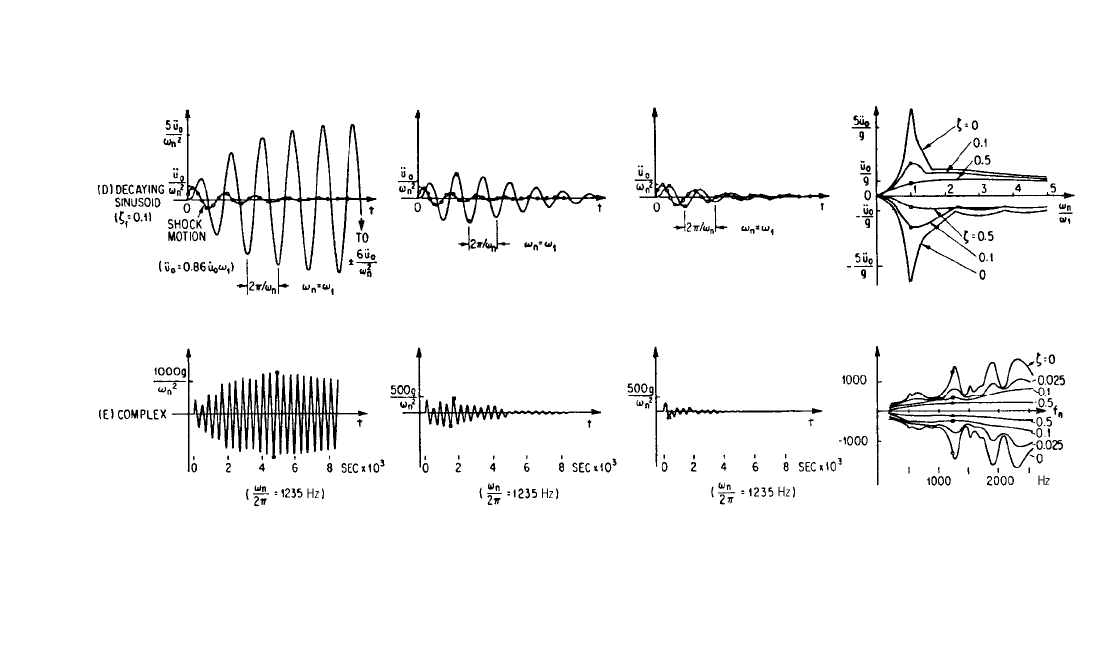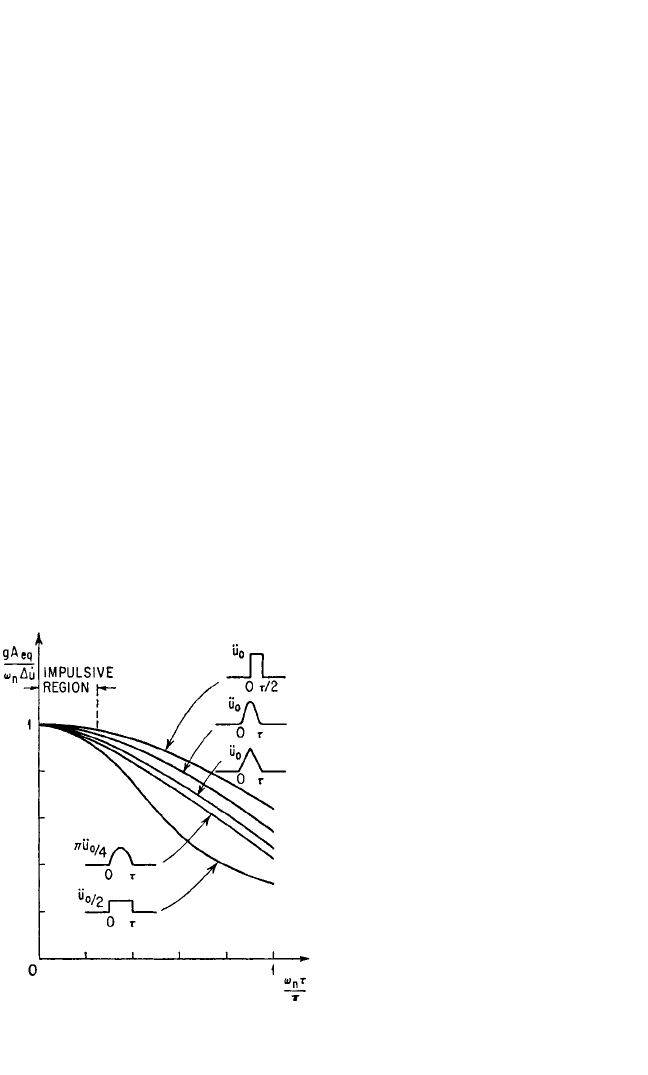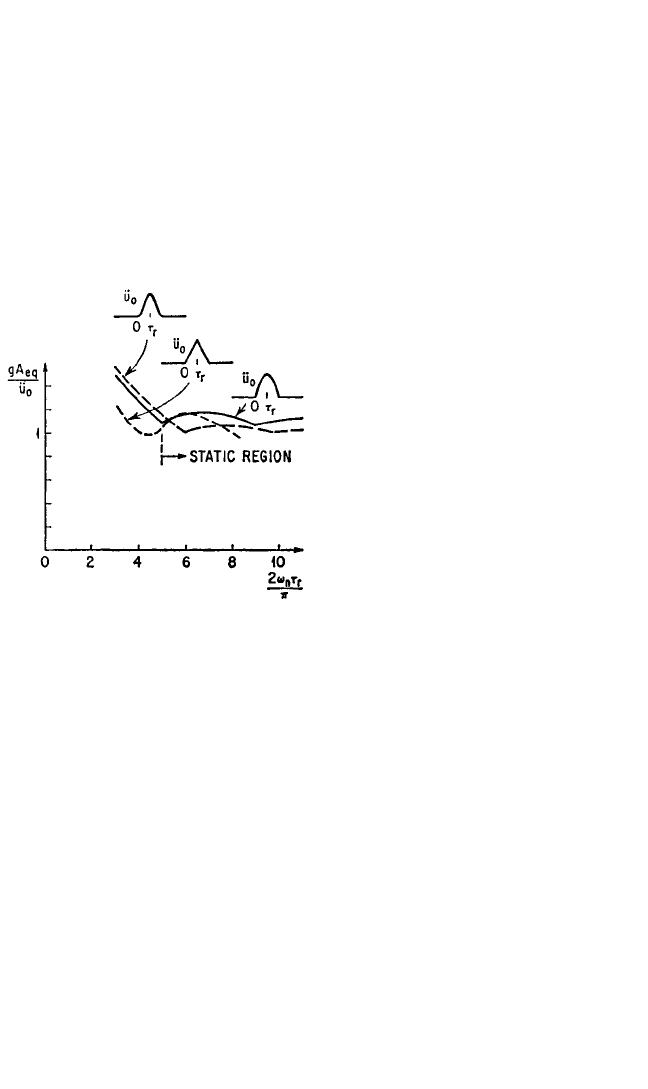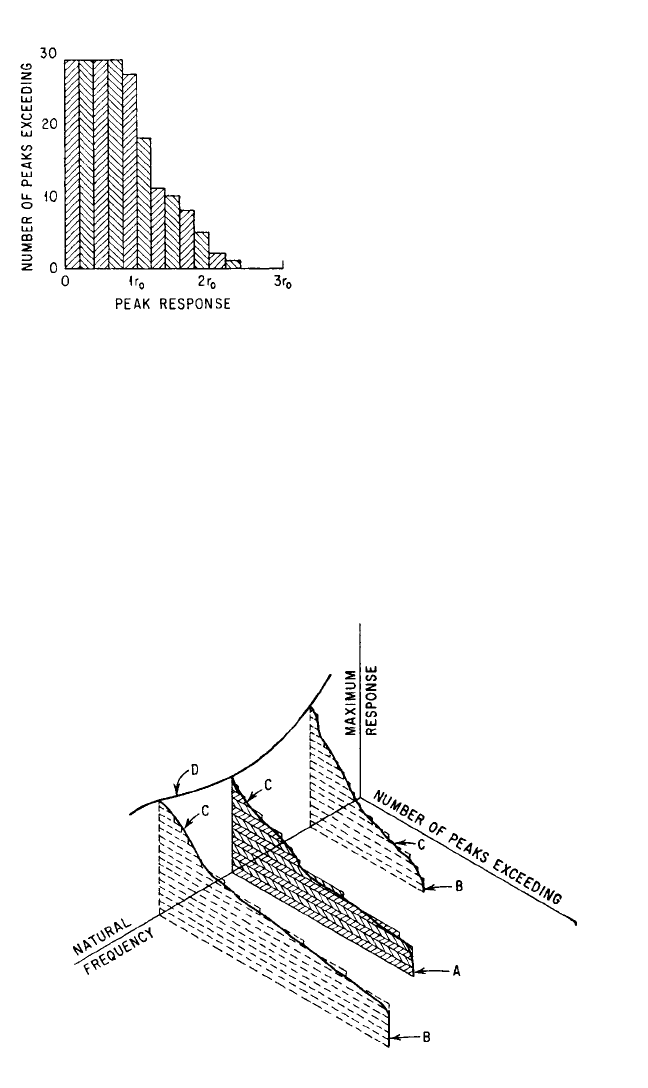Harris C.M., Piersol A.G. Harris Shock and vibration handbook
Подождите немного. Документ загружается.


23.17
FIGURE 23.7 Time-histories of response to shock motions defined in Fig. 23.2 and corresponding shock
response spectra.
8434_Harris_23_b.qxd 09/20/2001 12:02 PM Page 23.17

ing through the origin. The peak distortion of the structure δ
max
is inversely pro-
portional to frequency. Thus, the relative displacement of the mass increases as the
natural frequency decreases, whereas the equivalent static acceleration has an op-
posite trend.
ACCELERATION STEP: The response of a simple structure to the acceleration step
in Fig. 23.2B is found by substituting from Eq. (23.5) in Eq. (23.33) and integrating:
δ(t) =
1 − cos (ω
d
t − sin
−1
ζ)
[ζ<1] (23.42)
The responses δ(t) are shown in Fig. 23.7B for ζ=0, 0.1, and 0.5. The response over-
shoots the value ü
0
/ω
n
2
and then oscillates about this value as a mean with diminish-
ing amplitude as energy is dissipated by damping.An overshoot to 2ü
0
/ω
n
2
occurs for
zero damping. A response δ=ü
0
/ω
n
2
would result from a steady application of the
acceleration ü
0
.
The response maxima and minima occur at the times t = iπ/ω
d
, i = 0 providing the
first minimum and i = 1 the first maximum. The maximum values of the relative dis-
placement response are
δ
max
(ω
n
,ζ) =
1 + exp
−
[i odd] (23.43)
The largest positive response occurs at the first maximum, i.e., where i = 1, and is
shown by the solid symbols in Fig. 23.7B. The equivalent static acceleration in the pos-
itive direction is obtained by substitution of Eq. (23.43) into Eq. (23.34) with i = 1:
A
eq
+
(ω
n
,ζ) =
1 + exp
−
(23.44a)
The greatest negative response is zero; it occurs at t = 0, independent of the value of
damping, as shown by open symbols in Fig. 23.7B. Thus, the equivalent static accel-
eration in the negative direction is
A
eq
−
(ω
n
,ζ) = 0 (23.44b)
Since the equivalent static acceleration is independent of natural frequency, the
shock response spectrum curves shown in Fig. 23.7B are horizontal lines. The sym-
bols shown on the shock response spectra correspond to the responses shown.
The equivalent static acceleration for an undamped simple structure is twice the
value of the acceleration step ü
0
/g. As the damping increases, the overshoot in
response decreases; there is no overshoot when the structure is critically damped.
HALF-SINE ACCELERATION: The expressions for the response of the damped sim-
ple structure to the half-sine acceleration of Eq. (23.9) are too involved to have gen-
eral usefulness. For an undamped system, the response δ(t) is
δ(t) =
[sin ω
n
t − (ω
n
τ/π) sin (πt/τ)] [0 < t ≤τ]
δ(t) =
2 cos
sin
ω
n
t −
[t >τ]
(23.45)
For zero damping the residual response is sinusoidal with constant amplitude.
The first maximum in the response of a simple structure with natural frequency less
than π/τ occurs during the residual response; i.e., after t =τ. As a result, the magni-
τ
2
ω
n
τ
2
(ω
n
τ/π)
1 − (ω
n
τ/π)
2
ü
0
ω
n
2
(ω
n
τ/π)
1 − (ω
n
τ/π)
2
ü
0
ω
n
2
ζπ
1
−
ζ
2
ü
0
g
ζiπ
1
−
ζ
2
ü
0
ω
n
2
e
−ζω
n
t
1
−
ζ
2
ü
0
ω
n
2
23.18 CHAPTER TWENTY-THREE
8434_Harris_23_b.qxd 09/20/2001 12:02 PM Page 23.18

tude of each succeeding response peak is the same as that of the first maximum.Thus
the positive and negative shock response spectrum curves are equal for ω
n
≤π/τ.The
dot-dash curve in Fig. 23.7C is an example of the response at a natural frequency of
2π/3τ. The peak positive response is indicated by a solid circle, the peak negative
response by an open circle. The positive and negative shock response spectrum val-
ues derived from this response are shown on the undamped (ζ=0) shock response
spectrum curves at the right-hand side of Fig. 23.7C, using the same symbols.
At natural frequencies below π/2τ, the shock response spectra for an undamped
system are very nearly linear with a slope ±2ü
0
τ/πg. In this low-frequency region the
response is essentially impulsive; i.e., the maximum response is approximately the
same as that due to an ideal acceleration impulse (Fig. 23.7A) having a velocity
change ˙u
0
equal to the area under the half-sine acceleration time-history.
The response at the natural frequency 3π/τ is the dotted curve in Fig. 23.7C. The
displacement and velocity response are both zero at the end of the pulse, and hence
no residual response occurs. The solid and open triangles indicate the peak positive
and negative response, the latter being zero. The corresponding points appear on the
undamped shock response spectrum curves. As shown by the negative undamped
shock response spectrum curve, the residual spectrum goes to zero for all odd multi-
ples of π/τ above 3π/τ.
As the natural frequency increases above 3π/τ, the response attains the character
of relatively low amplitude oscillations occurring with the half-sine pulse shape as a
mean. An example of this type of response is shown by the solid curve for ω
n
= 8π/τ.
The largest positive response is slightly higher than ü
0
/ω
n
2
, and the residual response
occurs at a relatively low level. The solid and open square symbols indicate the
largest positive and negative response.
As the natural frequency becomes extremely high, the response follows the half-
sine shape very closely. In the limit, the natural frequency becomes infinite and the
response approaches the half-sine wave shown in Fig. 23.7C. For natural frequencies
greater than 5π/τ, the response tends to follow the input and the largest response is
within 20 percent of the response due to a static application of the peak input accel-
eration. This portion of the shock response spectrum is sometimes referred to as the
“static region” (see Limiting Values of Shock Response Spectrum below).
The equivalent static acceleration without damping for the positive direction is
A
eq
+
(ω
n
,0) =
cos
ω
n
≤
A
eq
+
(ω
n
,0) =
sin
ω
n
>
(23.46)
where i is the positive integer which maximizes the value of the sine term while the
argument remains less than π. In the negative direction the peak response always
occurs during the residual response; thus, it is given by the absolute value of the first
of the expressions in Eq. (23.46):
A
eq
−
(ω
n
,0) =
cos
(23.47)
Shock response spectra for damped systems are commonly found by use of a dig-
ital computer. Spectra for ζ=0.1 and 0.5 are shown in Fig. 23.7C.
The response of a damped structure whose natural frequency is less than π/2τ is
essentially impulsive; i.e., the shock response spectra in this frequency region are
substantially identical to the spectra for the acceleration impulse in Fig. 23.7A.
ω
n
τ
2
2(ω
n
τ/π)
1 − (ω
n
τ/π)
2
ü
0
g
π
τ
2iπ
(ω
n
τ/π) + 1
(ω
n
τ/π)
(ω
n
τ/π) − 1
ü
0
g
π
τ
ω
n
τ
2
2(ω
n
τ/π)
1 − (ω
n
τ/π)
2
ü
0
g
CONCEPTS IN SHOCK DATA ANALYSIS 23.19
8434_Harris_23_b.qxd 09/20/2001 12:02 PM Page 23.19

Except near the zeros in the negative spectrum for an undamped system, damping
reduces the peak response. For the positive spectra, the effect is small in the static
region since the response tends to follow the input for all values of damping. The
greatest effect of damping is seen in the negative spectra because it affects the decay
of response oscillations at the natural frequency of the structure.
DECAYING SINUSOIDAL ACCELERATION: Although analytical expressions for the
response of a simple structure to the decaying sinusoidal acceleration shown in Fig.
23.2D are available, calculation of spectra is impractical without use of a computer.
Figure 23.7D shows spectra for several values of damping in the decaying sinu-
soidal acceleration. In the low-frequency region (ω
n
< 0.2ω
1
), the response is essen-
tially impulsive. The area under the acceleration time-history of the decaying
sinusoid is ˙u
0
; hence, the response of a very low-frequency structure is similar to the
response to an acceleration impulse of magnitude ˙u
0
.
When the natural frequency of the responding system approximates the fre-
quency ω
1
of the oscillations in the decaying sinusoid, a resonant type of build-up
tends to occur in the response oscillations.The region in the neighborhood of ω
1
=ω
n
may be termed a quasi-resonant region of the shock response spectrum. Responses
for ζ=0, 0.1, and 0.5 and ω
n
=ω
1
are shown in Fig. 23.7D. In the absence of damping
in the responding system, the rate of build-up diminishes with time and the ampli-
tude of the response oscillations levels off as the input acceleration decays to very
small values. Small damping in the responding system, e.g., ζ=0.1, reduces the initial
rate of build-up and causes the response to decay to zero after a maximum is
reached. When damping is as large as ζ=0.5, no build-up occurs.
COMPLEX SHOCK: The shock spectra for the complex shock of Fig. 23.2E are
shown in Fig. 23.7E. Time-histories of the response of a system with a natural fre-
quency of 1,250 Hz also are shown. The ordinate of the spectrum plot is equivalent
static acceleration, and the abscissa is the natural frequency in hertz. Three pro-
nounced peaks appear in the spectra for zero damping, at approximately 1,250 Hz,
1,900 Hz, and 2,350 Hz. Such peaks indicate a concentration of frequency content in
the shock, similar to the spectra for the decaying sinusoid in Fig. 23.7D. Other peaks
in the shock spectra for an undamped system indicate less significant oscillatory
behavior in the shock. The two lower frequencies at which the pronounced peaks
occur correlate with the peaks in the Fourier spectrum of the same shock, as shown
in Fig. 23.3E. The highest frequency at which a pronounced peak occurs is above the
range for which the Fourier spectrum was calculated.
Because of response limitations of the analysis, the shock spectra do not extend
below 200 Hz. Since the duration of the complex shock of Fig. 23.2E is about 0.016
sec, an impulsive-type response occurs only for natural frequencies well below 200
Hz. As a result, no impulsive region appears in the shock response spectra. There is
no static region of the spectra shown because calculations were not extended to a
sufficiently high frequency.
In general, the equivalent static acceleration A
eq
is reduced by additional damp-
ing in the responding structure system except in the region of valleys in the shock
spectra, where damping may increase the magnitude of the spectrum. Positive and
negative spectra tend to be approximately equal in magnitude at any value of damp-
ing; thus, the spectra for a complex oscillatory type of shock may be based on peak
response independent of sign to a good approximation.
Limiting Values of Shock Response Spectrum. The response data provided by
the shock response spectrum sometimes can be abstracted to simplified parameters
that are useful for certain purposes. In general, this cannot be done without definite
information on the ultimate use of the reduced data, particularly the natural fre-
23.20 CHAPTER TWENTY-THREE
8434_Harris_23_b.qxd 09/20/2001 12:02 PM Page 23.20

quencies of the structures upon which the shock acts. Two important cases are dis-
cussed in the following sections.
IMPULSE OR VELOCITY CHANGE: The duration of a shock sometimes is much
smaller than the natural period of a structure upon which it acts. Then the entire
response of the structure is essentially a function of the area under the time-history
of the shock, described in terms of acceleration or a loading parameter such as force,
pressure, or torque. Consequently, the shock has an effect which is equivalent to that
produced by an impulse of infinitesimally short duration, i.e., an ideal impulse.
The shock response spectrum of an ideal impulse is shown in Fig. 23.7A. All
equivalent static acceleration curves are straight lines passing through the origin.
The portion of the spectrum exhibiting such straight-line characteristics is termed
the impulsive region. The shock response spectrum of the half-sine acceleration
pulse has an impulsive region when ω
n
is less than approximately π/2τ, as shown in
Fig. 23.7C. If the area under a time-history of acceleration or shock loading is not
zero or infinite, an impulsive region exists in the shock response spectrum. The
extent of the region on the natural frequency axis depends on the shape and dura-
tion of the shock.
The portions adjacent to the origin of the positive shock response spectra of an
undamped system for several single pulses of acceleration are shown in Fig. 23.8. To
illustrate the impulsive nature, each spectrum is normalized with respect to the peak
impulsive response ω
n
∆˙u/g, where ∆ ˙u is the area under the corresponding accelera-
tion time-history. Hence, the spectra indicate an impulsive response where the ordi-
nate is approximately 1. The response to a single pulse of acceleration is impulsive
within a tolerance of 10 percent if ω
n
< 0.25π/τ; i.e., f
n
< 0.4τ
−1
, where f
n
is the natural
frequency of the responding structure in hertz and τ is the pulse duration in seconds.
This result also applies when the responding system is damped. Thus, it is possible to
reduce the description of a shock pulse to a designated velocity change when the
natural frequency of the responding
structure is less than a specified value.
The magnitude of the velocity change is
the area under the acceleration pulse:
∆ ˙u =
τ
0
ü(t) dt (23.48)
PEAK ACCELERATION OR LOADING:
The natural frequency of a structure
responding to a shock sometimes is suf-
ficiently high that the response oscilla-
tions of the structure at its natural
frequency have a relatively small ampli-
tude. Examples of such responses are
shown in Fig. 23.7C for ω
n
= 8π/τ and
ζ=0, 0.1, 0.5. As a result, the maximum
response of the structure is approxi-
mately equal to the maximum accel-
eration of the shock and is termed
equivalent static response. The magni-
tude of the spectra in such a static region
is determined principally by the peak
value of the shock acceleration or load-
CONCEPTS IN SHOCK DATA ANALYSIS 23.21
FIGURE 23.8 Portions adjacent to the origin
of the positive spectra of an undamped system
for several single pulses of acceleration.
8434_Harris_23_b.qxd 09/20/2001 12:02 PM Page 23.21

ing. Portions of the positive spectra of an undamped system in the region of high nat-
ural frequencies are shown in Fig. 23.9 for a number of acceleration pulses. Each
spectrum is normalized with respect to the maximum acceleration of the pulse. If the
ordinate is approximately 1, the shock response spectrum curves behave approxi-
mately in a static manner.
The limit of the static region in terms of the natural frequency of the structure is
more a function of the slope of the acceleration time-history than of the duration of
the pulse. Hence, the horizontal axis of the shock response spectra in Fig. 23.9 is
given in terms of the ratio of the rise time τ
r
to the maximum value of the pulse. As
shown in Fig. 23.9, the peak response to a single pulse of acceleration is approxi-
mately equal to the maximum acceleration of the pulse, within a tolerance of 20 per-
cent, if ω
n
> 2.5π/τ
r
; i.e., f
n
> 1.25τ
r
−1
,
where f
n
is the natural frequency of the
responding structure in hertz and τ
r
is
the rise time to the peak value in sec-
onds.The tolerance of 20 percent applies
to an undamped system; for a damped
system, the tolerance is lower, as indi-
cated in Fig. 23.7C.
The concept of the static region also
can be applied to complex shocks. Sup-
pose the shock is oscillatory, as shown in
Fig. 23.2E. If the response to such a shock
is to be nearly static, the response to each
of the succession of pulses that make up
the shock must be nearly static. This is
most significant for pulses of large mag-
nitude because they determine the ordi-
nate of the spectrum in the static region.
Therefore, the shock response spectrum
for a complex shock in the static region is
based upon the pulses of greatest magni-
tude and shortest rise time.
Three-Dimensional Shock Response Spectrum.
7
In general, the response of a
structure to a shock is oscillatory and continues for an appreciable number of oscil-
lations. At each oscillation, the response has an interim maximum value that differs,
in general, from the preceding or following maximum value. For example, a typical
time-history of response of a simple system of given natural frequency is shown in
Fig. 23.6; the characteristics of the response may be summarized by the block dia-
gram of Fig. 23.10. The abscissa of Fig. 23.10 is the peak response at the respective
cycles of the oscillation, and the ordinate is the number of cycles at which the peak
response exceeds the indicated value. Thus, the time-history of Fig. 23.6 has 29 cycles
of oscillation at which the peak response of the oscillation exceeds 0.6r
0
, but only 2
cycles at which the peak response exceeds 2.0r
0
.
In accordance with the concept of the shock response spectrum, the natural fre-
quency of the responding system is modified by discrete increments and the response
determined at each increment. This leads to a number of time-histories of response
corresponding to Fig. 23.6, one for each natural frequency, and a similar number of
block diagrams corresponding to Fig. 23.10. This group of block diagrams can be
assembled to form a surface that shows pictorially the characteristics of the shock in
terms of the response of a simple system. The axes of the surface are peak response,
23.22 CHAPTER TWENTY-THREE
FIGURE 23.9 Portions of the positive shock
response spectra of an undamped system with
high natural frequencies for several single pulses
of acceleration.
8434_Harris_23_b.qxd 09/20/2001 12:02 PM Page 23.22

natural frequency of the responding sys-
tem, and number of response cycles ex-
ceeding a given peak value. The block
diagram of Fig. 23.10 is arranged on this
set of axes at A, as shown in Fig. 23.11, at
the appropriate position along the natu-
ral frequency axis. Other corresponding
block diagrams are shown at B. The
three-dimensional shock response spec-
trum is conceptually the surface faired
through the ends of the bars; the inter-
cept of this surface with the planes of the
block diagrams is indicated at C and that
with the maximum response–natural fre-
quency plane at D. Surfaces are obtain-
able for both positive and negative values
of the response, and a separate surface is
obtained for each fraction of critical damping in the responding system.
The two-dimensional shock response spectrum is a special case of the three-
dimensional surface. The former is a plot of the maximum response as a function of
the natural frequency of the responding system; hence, it is a projection on the plane
of the response and natural frequency axes of the maximum height of the surface.
However, the height of the surface never exceeds that at one response cycle. Thus,
the two-dimensional shock response spectrum is the intercept of the surface with a
plane normal to the “number of peaks exceeding” axis at the origin.
The response surface is a useful concept and illustrates a physical condition.
However, it is not well adapted to quantitative analysis because the distances from
CONCEPTS IN SHOCK DATA ANALYSIS 23.23
FIGURE 23.10 Bar chart for the response of a
system to a shock excitation.
FIGURE 23.11 Example of a three-dimensional shock response spectrum.
8434_Harris_23_b.qxd 09/20/2001 12:02 PM Page 23.23

the surface to the coordinate planes cannot be determined readily. A group of bar
charts, each corresponding to Fig. 23.10, is more useful for quantitative purposes.The
differences in lengths of the bars are discrete increments; this corresponds to the
data reduction method in which the axis of response magnitudes is divided into dis-
crete increments for purposes of counting the number of peaks exceeding each mag-
nitude. In concept, the width of the increment may be considered to approach zero
and the line faired through the ends of the bars represents the smooth intercept with
the surface.
Relationship between Shock Response Spectrum and Fourier Spectrum.
Although the shock response spectrum and the Fourier spectrum are fundamentally
different, there is a partial correlation between them. A direct relationship exists
between a running Fourier spectrum, to be defined subsequently, and the response
of an undamped simple structure. A consequence is a simple relationship between
the Fourier spectrum of absolute values and the peak residual response of an
undamped simple structure.
For the case of zero damping, Eq. (23.33) provides the relative displacement
response
δ(ω
n
,t) =
t
0
ü(t
v
) sin ω
n
(t − t
v
) dt
v
(23.49)
A form better suited to our needs here is
δ(ω
n
,t) = I
e
jω
n
t
t
0
ü(t
v
) e
−jω
n
t
v
dt
v
(23.50)
The integral above is seen to be the Fourier spectrum of the portion of ü(t) which lies
in the time interval from zero to t, evaluated at the natural frequency ω
n
. Such a
time-dependent spectrum can be termed a “running Fourier spectrum” and denoted
by F(ω,t):
F(ω,t) =
t
0
ü(t
v
)e
−jωt
v
dt
v
(23.51)
It is assumed that the excitation vanishes for t < 0. The integral in Eq. (23.50) can be
replaced by F(ω
n
,t); and after taking the imaginary part
δ(ω
n
,t) = F(ω
n
,t) sin [ω
n
t +θ(ω
n
,t)] (23.52)
where F(ω
n
,t) and θ(ω
n
,t) are the magnitude and phase of the running Fourier spec-
trum, corresponding to the definitions in Eqs. (23.63) and (23.64). Equation (23.52)
provides the previously mentioned direct relationship between undamped structural
response and the running Fourier spectrum.
When the running time t exceeds τ, the duration of ü(t), the running Fourier spec-
trum becomes the usual spectrum as given by Eq. (23.57), with τ used in place of the
infinite upper limit of the integral. Consequently, Eq. (23.52) yields the sinusoidal
residual relative displacement for t >τ:
δ
r
(ω
n
,t) = F(ω
n
) sin [ω
n
t +θ(ω
n
)] (23.53)
The amplitude of this residual deflection and the corresponding equivalent static
acceleration are
1
ω
n
1
ω
n
1
ω
n
1
ω
n
23.24 CHAPTER TWENTY-THREE
8434_Harris_23_b.qxd 09/20/2001 12:02 PM Page 23.24

(δ
r
)
max
= F(ω
n
)
(A
eq
)
r
==F(ω
n
)
(23.54)
This result is clearly evident for the Fourier spectrum and undamped shock response
spectrum of the acceleration impulse. The Fourier spectrum is the horizontal line
(independent of frequency) shown in Fig. 23.3A and the shock response spectrum is
the inclined straight line (increasing linearly with frequency) shown in Fig. 23.7A.
Since the impulse exists only at t = 0, the entire response is residual. The undamped
shock spectra in the impulsive region of the half-sine pulse and the decaying sinu-
soidal acceleration, Fig. 23.7C and D, respectively, also are related to the Fourier spec-
tra of these shocks, Fig. 23.3C and D, in a similar manner. This results from the fact
that the maximum response occurs in the residual motion for systems with small nat-
ural frequencies. Another example is the entire negative shock response spectrum
with no damping for the half-sine pulse in Fig. 23.7C, whose values are ω
n
/g times the
values of the Fourier spectrum in Fig. 23.3C.
METHODS OF DATA REDUCTION
Even though preceding sections of this chapter include several analytic functions as
examples of typical shocks, data reduction in general is applied to measurements of
shock that are not definable by analytic functions. The following sections outline
data reduction methods that are adapted for use with any general type of function,
obtained in digital form in practice. Standard forms for presenting the analysis
results are given in Ref. 8.
FOURIER SPECTRUM
The Fourier spectrum is computed using the discrete Fourier transform (DFT)
defined in Eq. (14.6). The DFT is commonly computed using a fast Fourier trans-
form (FFT) algorithm, as discussed in Chap. 14 (see Ref. 9 for details on FFT com-
putations). Fourier spectra can be computed as a function of either radial frequency
ω in radians/sec or cyclical frequency f in Hz, that is,
F
1
(f) =
∞
−∞
x(t)e
−j2πft
dt or F
2
(ω) =
∞
−∞
x(t)e
−jωt
dt (23.55)
where the two functions are related by F
2
(ω) = 2πF
1
(f).
SHOCK RESPONSE SPECTRUM
The shock response spectrum can be computed by the following techniques: (a)
direct numerical or recursive integration of the Duhamel integral in Eq. (23.33), or
(b) convolution or recursive filtering procedures. One of the most widely used pro-
grams for computing the shock response spectrum is the “ramp invariant method”
detailed in Ref. 10.Any of these computational procedures can be modified to count
ω
n
g
ω
n
2
(δ
r
)
max
g
1
ω
n
CONCEPTS IN SHOCK DATA ANALYSIS 23.25
8434_Harris_23_b.qxd 09/20/2001 12:02 PM Page 23.25

the number of response maxima above various discrete increments of maximum
response to obtain the results depicted in Fig. 23.11.
Reed Gage. The shock spectrum may be measured directly by a mechanical
instrument that responds to shock in a manner analogous to the data reduction tech-
niques used to obtain shock spectra from time-histories. The instrument includes a
number of flexible mechanical systems that are considered to respond as single
degree-of-freedom systems; each system has a different natural frequency, and
means are provided to indicate the maximum deflection of each system as a result of
the shock. The instrument often is referred to as a reed gage because the flexible
mechanical systems are small cantilever beams carrying end masses; these have the
appearance of reeds.
11
The response parameter indicated by the reed gage is maximum deflection of the
reeds relative to the base of the instrument; generally, this deflection is converted to
equivalent static acceleration by applying the relation of Eq. (23.30). The reed gage
offers a convenience in the indication of a useful quantity immediately and in the
elimination of auxiliary electronic equipment. Also, it has important limitations: (1)
the information is limited to the determination of a shock response spectrum; (2) the
deflection of a reed is inversely proportional to its natural frequency squared,
thereby requiring high equivalent static accelerations to achieve readable records at
high natural frequencies; (3) the means to indicate maximum deflection of the reeds
(styli inscribing on a target surface) tend to introduce an undefined degree of damp-
ing; and (4) size and weight limitations on the reed gage for a particular application
often limit the number of reeds which can be used and the lowest natural frequency
for a reed. In spite of these limitations, the instrument sees continued use and has
provided significant shock response spectra where more elaborate instruments have
failed.
REFERENCES
1. Scavuzzo, R. J., and H. C. Pusey:“Principles and Techniques of Shock Data Analysis,” SVM-
16, 2d ed., Shock and Vibration Information Analysis Center, Arlington, Va., 1996.
2. Rubin, S.: J. Appl. Mechanics, 25:501 (1958).
3. Fung,Y. C., and M. V. Barton: J.Appl. Mechanics, 25:365 (1958).
4. Kern, D. L., et al.: “Dynamic Environmental Criteria,” NASA-HDBK-7005, 2001.
5. Walsh, J. P., and R. E. Blake: Proc. Soc. Exptl. Stress Anal., 6(2):150 (1948).
6. Weaver, W, Jr., S. P. Timoshenko, and D. H. Young: “Vibration Problems in Engineering,”
5th ed., John Wiley & Sons, Inc., New York, 1990.
7. Lunney, E. J., and C. E. Crede: WADC Tech. Rept. 57-75, 1958.
8. “Methods for the Analysis of Shock and Vibration Data,” ANCI S2.10-1971, R1997.
9. Brigham, E. O.: “The Fast Fourier Transform and Its Applications,” Prentice-Hall, Inc.,
Englewood Cliffs, N.J., 1988.
10. Smallwood, D. O.: Shock and Vibration Bull., 56(1):279 (1986).
11. Rubin, S.: Proc. Soc. Exptl. Stress Anal., 16(2):97 (1956).
23.26 CHAPTER TWENTY-THREE
8434_Harris_23_b.qxd 09/20/2001 12:02 PM Page 23.26
